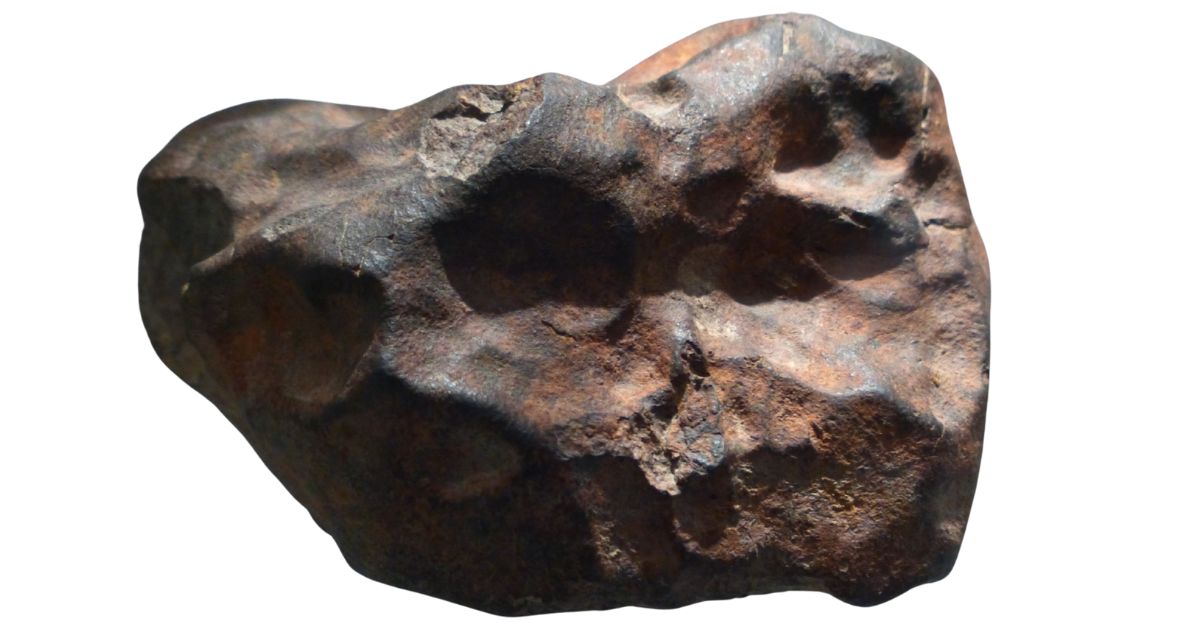Florida might not seem like a place to find meteorites, but it offers some great opportunities for those willing to look. While the humid weather and thick vegetation can make things tricky, some amazing meteorites have already been found here.
With the right tips, you might be the next person to make a discovery. Finding one takes patience and sharp eyes, but it’s an exciting challenge.
From farmlands to beaches and open fields, Florida offers plenty of places to start your search. With so many opportunities and a little knowledge, you might be closer to finding a meteorite than you think!
The Types Of Meteorites You Can Find
When you’re out searching there are several types of meteorites that you can find and need to be aware of. They each have their own characteristics and compositions that can make identifying them a bit different.
These are the main types to keep an eye out for:
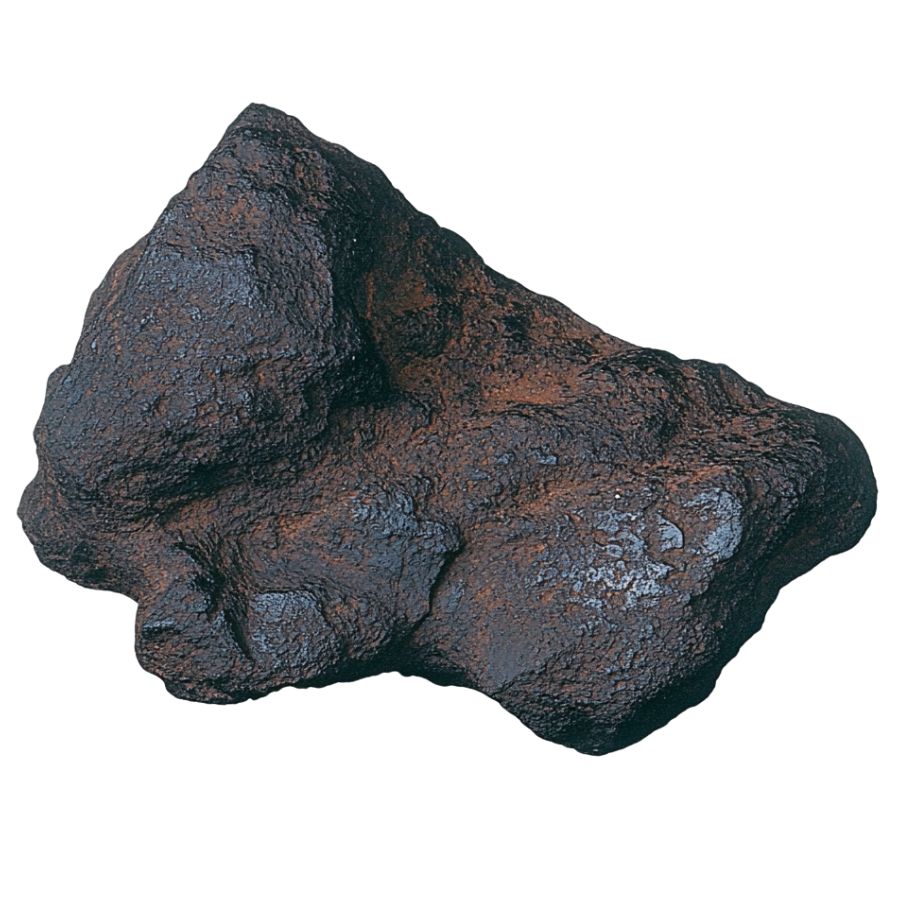
Iron meteorites
Iron meteorites are fragments of ancient metallic cores from planetesimals, the building blocks of planets. These meteorites are primarily made of iron and nickel, with small amounts of other metals like cobalt.
They are thought to originate from the cores of differentiated celestial bodies that were destroyed by collisions in space billions of years ago.
Iron meteorites are nearly entirely metallic. This gives them a high density and makes them magnetic. They are also more resistant to weathering, which is why they are often found in better condition than other types of meteorites.
When discovered, iron meteorites often have a dark, rusted exterior due to oxidation. If freshly fallen, they may exhibit a shiny, metallic fusion crust formed as they burned through Earth’s atmosphere.
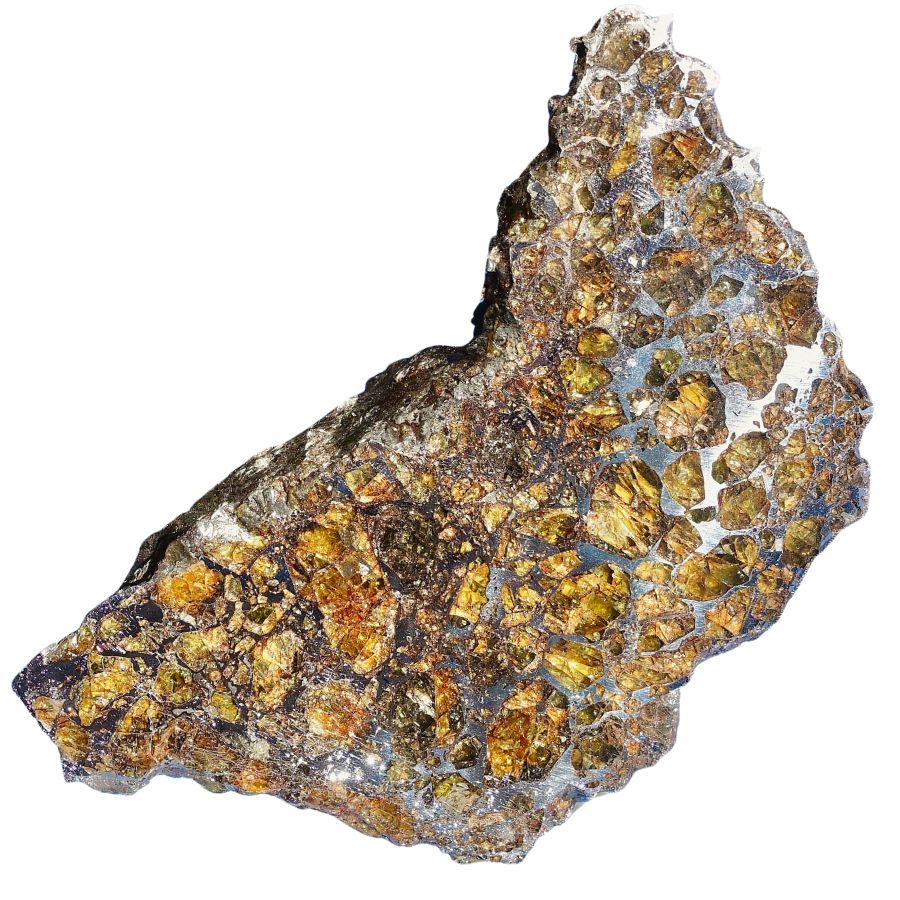
Pallasites
Pallasite meteorites are a rare and beautiful type of stony-iron meteorite that captures attention with their unique appearance and fascinating origins. They are composed of a mix of metal and silicate minerals, primarily olivine, a greenish-yellow crystal that is often gem-quality.
These crystals are embedded within a matrix of nickel-iron metal, giving pallasites a striking, almost gemstone-like look when cut and polished.
Scientists believe pallasites originate from the boundary layer of an asteroid’s core and mantle, forming when molten metal and silicate material mixed during a catastrophic impact or asteroid disruption billions of years ago.
When found in the field, pallasites often appear as irregular, weathered masses with a rusty exterior caused by the oxidation of their metal content.
However, once sliced open, their interior reveals the mesmerizing olivine crystals encased in a shiny metallic framework, offering a glimpse into the dynamic processes that shaped our solar system.
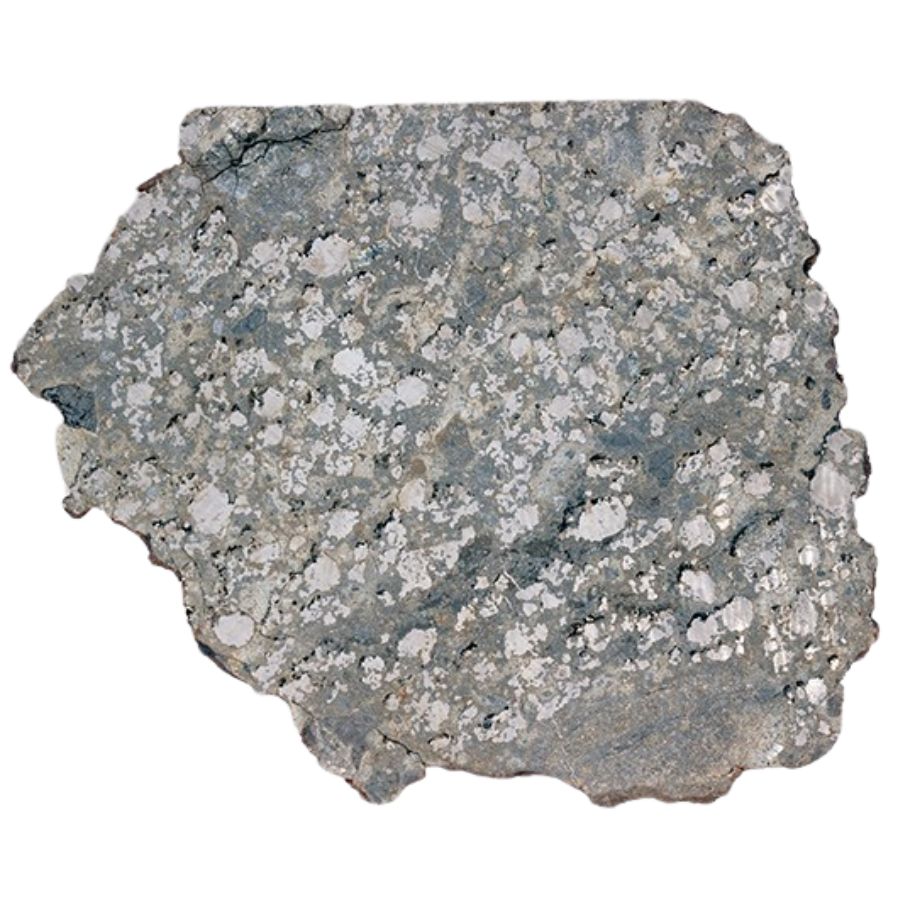
Mesosiderites
Mesosiderites contain a unique mix of metal and silicate material. They are composed roughly of equal parts nickel-iron metal and silicate rock, which includes minerals like pyroxene, plagioclase, and olivine.
This unusual combination suggests a complex history, possibly involving a violent collision between an asteroid with a metallic core and another asteroid with a rocky crust. The impact mixed their materials, forming the distinctive structure of mesosiderites.
Unlike other meteorites, mesosiderites stand out because they don’t have the same layered or uniform appearance as most stony or iron meteorites. Instead, their structure is a jumbled mixture of shiny metallic chunks embedded in a rocky matrix.
When found in the field, mesosiderites often appear as dark, irregular masses. They may have a fusion crust from their fiery entry into Earth’s atmosphere, but their internal structure is what truly defines them.
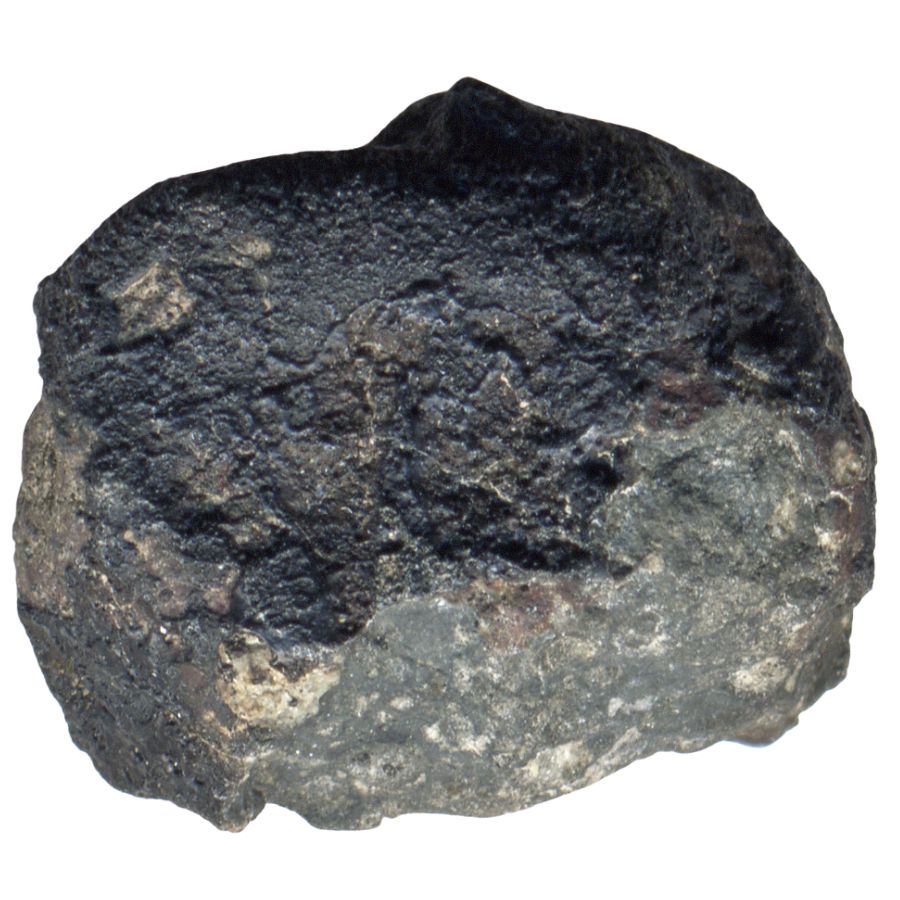
Carbonaceous chondrite
Carbonaceous chondrite meteorites are believed to be some of the oldest and most primitive materials in the solar system, forming about 4.6 billion years ago. These meteorites are thought to originate from asteroids in the outer regions of the asteroid belt and possibly from comets.
Their composition is unique compared to other meteorites as they contain high levels of carbon and organic compounds, including amino acids, which are essential for life. They also often include water-bearing minerals, tiny silicate grains, and small, round structures called chondrules.
They often have a dark, black, or gray appearance due to their carbon content, and their surfaces can be rough or brittle. When freshly fallen, they may have a thin fusion crust caused by the intense heat of atmospheric entry, but this crust can erode over time if the meteorite is exposed to the elements.
When found, they often appear as dark rocks, sometimes with a powdery or crumbly texture, and they stand out in contrast to surrounding terrain, especially in deserts or icy regions. Their fragile composition means they must be handled carefully to preserve their unique features.
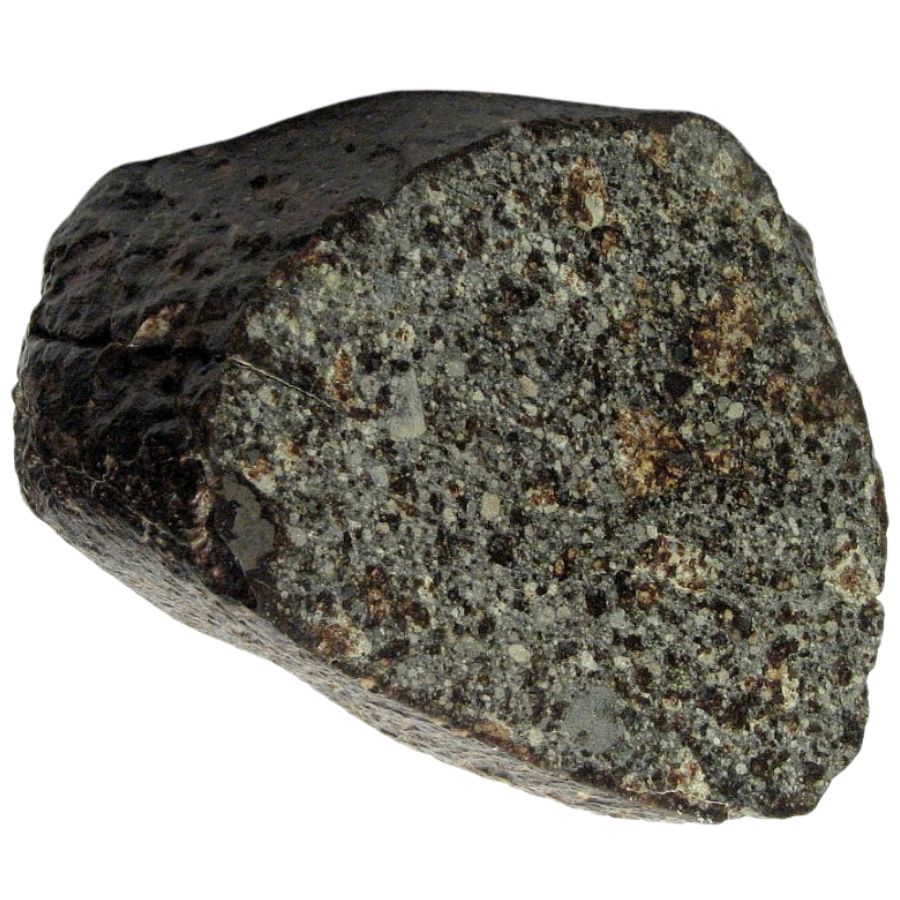
Ordinary chondrite
Ordinary chondrite meteorites are the most common type of meteorite, making up about 80% of all meteorites that fall to Earth. They are stony meteorites and are primarily composed of silicate minerals, such as olivine and pyroxene, along with varying amounts of nickel-iron metal and sulfides.
Their name comes from the small, round particles called chondrules found within them. Chondrules are tiny, spherical grains that formed as molten droplets in the early solar system over 4.5 billion years ago.
These meteorites originate from the asteroid belt between Mars and Jupiter. They are fragments of larger asteroids that broke apart due to collisions.
When found, ordinary chondrites typically have a thin, dark fusion crust formed by the intense heat of atmospheric entry. The interior is a mix of light-colored silicate minerals and shiny metal flakes.
They are often denser than terrestrial rocks and may attract a magnet due to their metallic content. Over time, weathering can alter their appearance, causing the metal to rust and the surface to develop a reddish-brown patina.
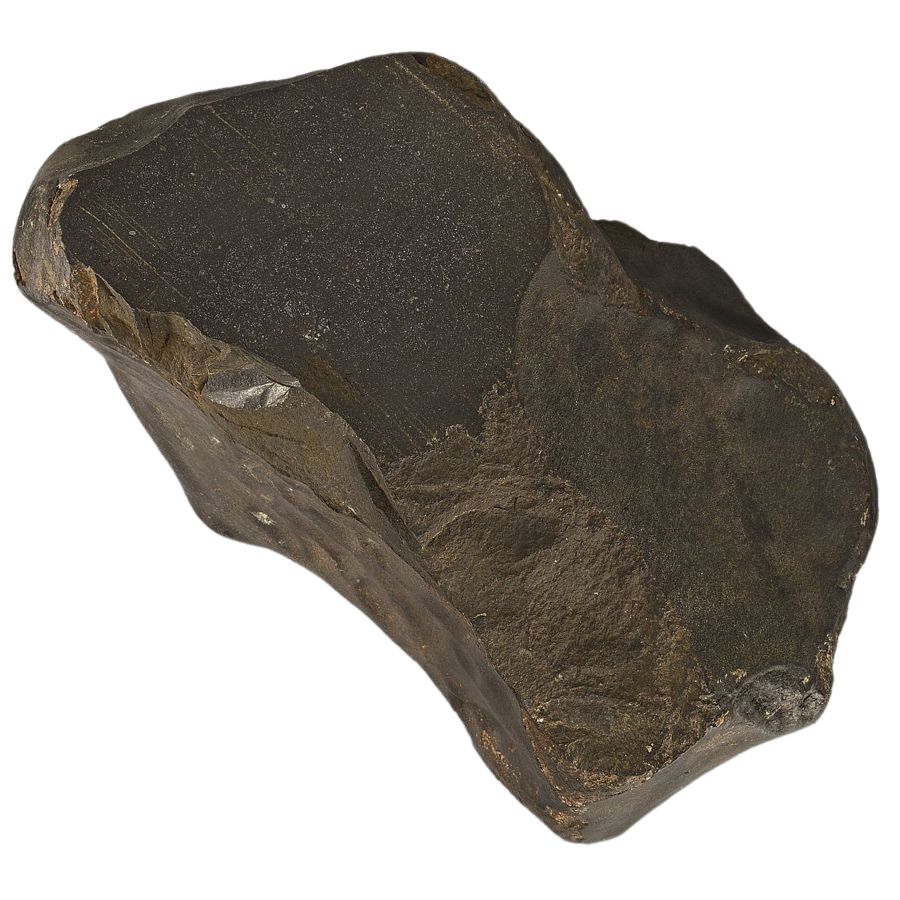
Enstatite chondrite
Enstatite chondrite meteorites are a rare type of stony meteorite that are composed primarily of the mineral enstatite, a magnesium-rich silicate, along with other unique minerals like oldhamite, schreibersite, and troilite, which are rare on Earth.
These meteorites are highly reduced, meaning they contain very little oxygen compared to other meteorite types, and often include metallic iron and sulfides.
Their chemical composition suggests they formed in a low-oxygen environment, likely close to the young Sun.
Enstatite chondrites are thought to represent the building blocks of certain planetary bodies, including Mercury and possibly the Earth itself.
When found, enstatite chondrites often appear weathered and may have a dull, gray to brown color due to oxidation. Freshly fallen specimens, however, display a dark fusion crust from atmospheric entry and may show metallic specks or small crystals when broken open.
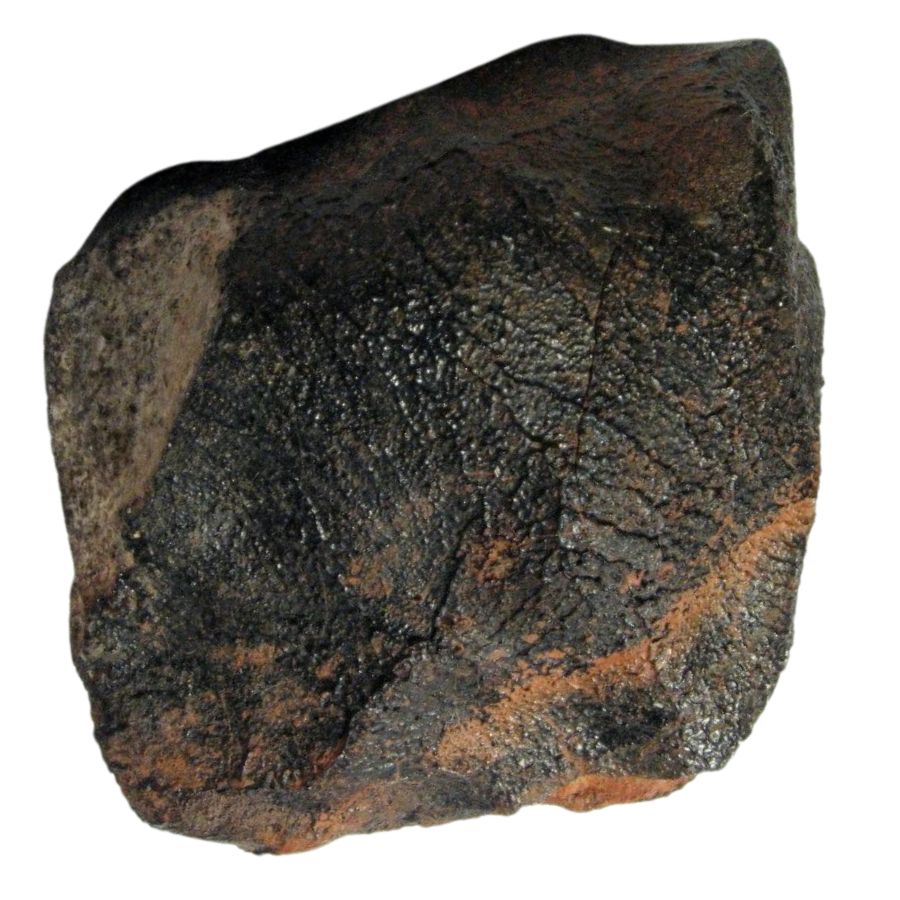
Achondrites
Achondrites are a rare type of stony meteorite that originate from asteroids, planets, or moons. They are composed primarily of silicate minerals, like pyroxene, olivine, and plagioclase, and often resemble volcanic rocks found on Earth.
Achondrites are thought to come from large celestial bodies that underwent heating and differentiation, a process where heavier materials, like metals, sink to the core, while lighter silicates form a crust.
For example, some achondrites are believed to come from the crust of asteroids like Vesta, while others may have originated on Mars or the Moon.
When found, achondrites often have a dark, fusion-crusted surface caused by their fiery entry through Earth’s atmosphere. Inside, they can display a range of colors, from light gray to green or black, depending on their mineral content.
They are usually dense and have a fine-grained texture, similar to igneous rocks on Earth, making them harder to identify as meteorites compared to iron-rich types.
Where Finding Meteorites Can Be Easier
Now that you have a better idea of WHAT you’re looking for let’s talk about some of the more general locations you should target first.
After this, we’ll dive into specific places around the state that are particularly good places to start.
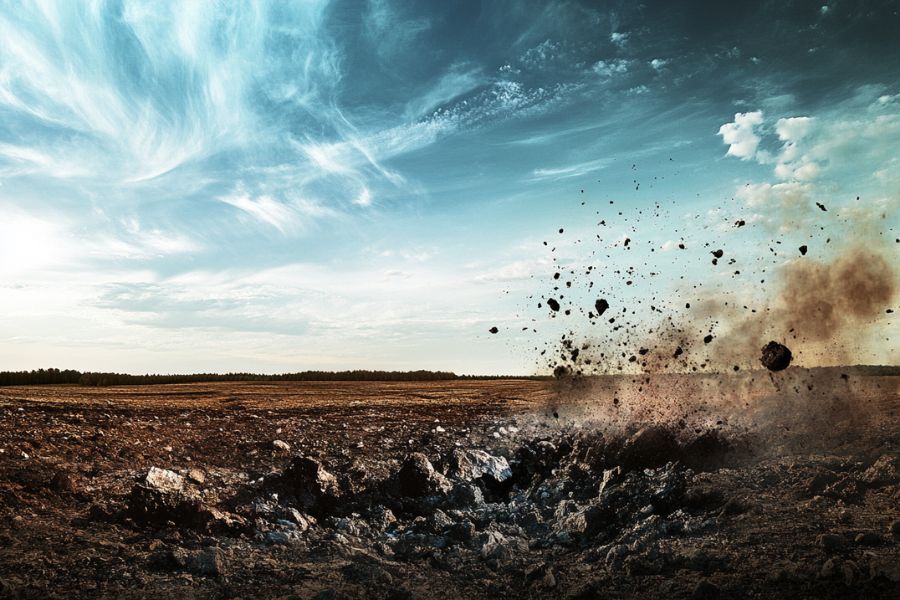
Strewn fields
Before you start hunting individual meteorites you might want to try hunting in a strewn field. These are areas where fragments of a single meteorite fall have been scattered across the ground.
When a large meteorite enters Earth’s atmosphere, it often breaks apart due to intense heat and pressure, causing pieces to spread out along its trajectory. These areas, known as strewn fields, are concentrated with meteorite fragments, making them a logical and rewarding target for meteorite hunters.
Most strewn fields are on private land and will charge a fee to search but it can be well worth it, especially for a novice hunter just getting started.
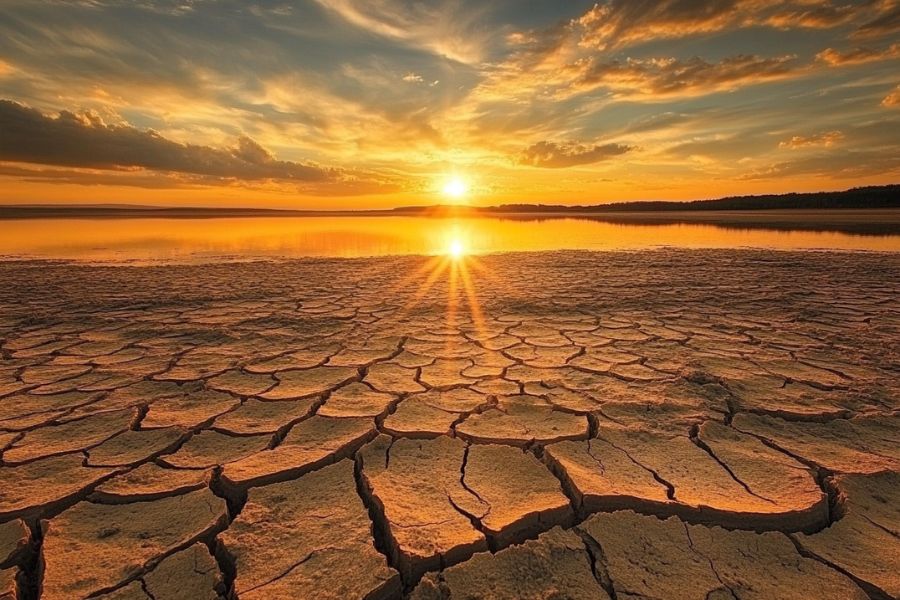
Dry lake beds
Dry lake beds are excellent places to search for meteorites because they are flat, open, and have minimal vegetation, making it easier to spot unusual rocks that may have fallen from space. These environments also have limited water flow and erosion, which helps preserve meteorites over time.
When water was present in the past, it often carried lighter materials away, concentrating denser meteorites on the surface or just below it.
Start by scanning for rocks that seem out of place compared to the native geology of the area. Meteorites often appear darker and have a smoother fusion crust, which is a thin, glassy layer formed as the meteorite burns up in Earth’s atmosphere.

Rooftops
Large rooftops, especially from industrial buildings, are great places to find meteorites because they act as natural collectors for small debris falling from the sky. Over time, particles from meteorites that survive their journey through Earth’s atmosphere can settle on flat, open rooftops where they remain undisturbed.
Industrial rooftops are particularly good because they often have wide, flat surfaces with minimal human activity, reducing the chances of meteorite particles being swept away or covered by other materials.
When searching a rooftop, look for tiny black or dark metallic particles that are magnetic, as most meteorites contain iron. You can use a strong magnet wrapped in cloth to pick up these particles without damaging them.
Finding rooftops that haven’t been cleaned in years is your best bet but always make sure you have permission to search and investigate any potential hazards associated with the building or associated businesses.
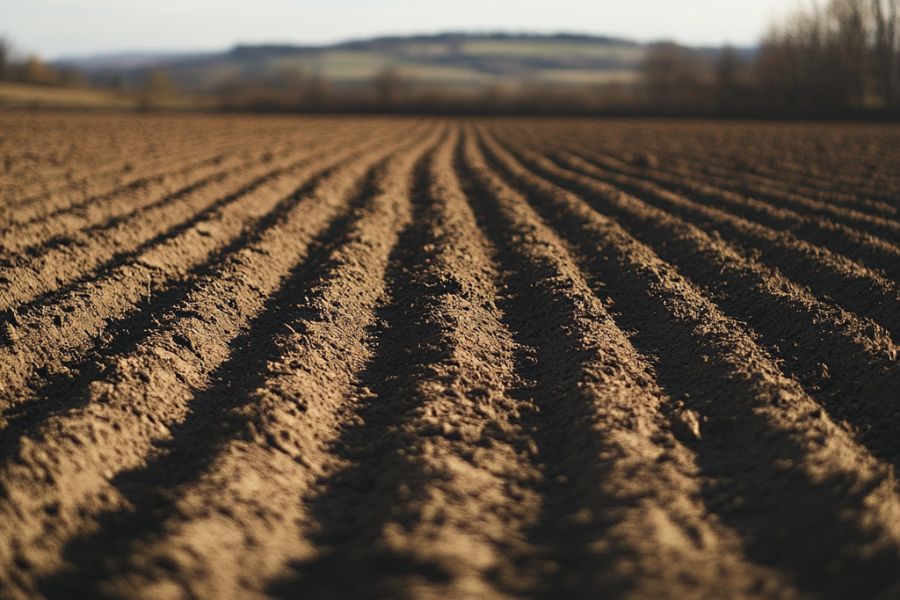
Agricultural fields
Agricultural fields are regularly plowed, which can bring buried meteorites to the surface. The open, flat landscape of a field also makes it easier to spot unusual rocks that don’t match the local geology.
Since most meteorites are dense and magnetic, they stand out from typical soil and rocks found in agricultural areas. Over time, meteorites can sink into the ground, but farming activities, like plowing or tilling, help expose them again.
Many fields will have had most rocks removed over time so any rock that you do find is worth taking a look at.
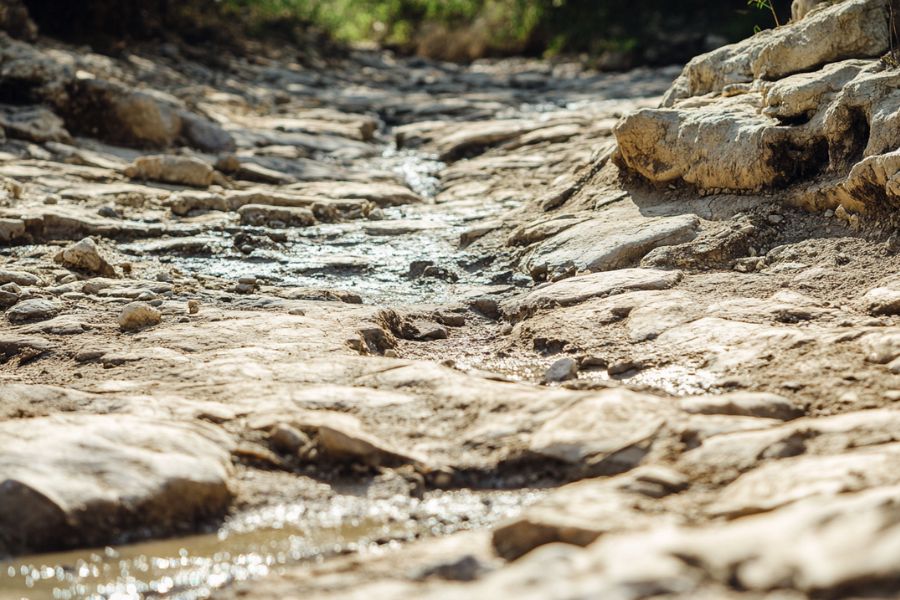
Dry riverbeds and creeks
Dry riverbeds and creeks act as natural channels that collector heavy objects. Over time, flowing water moves lighter materials like sand and small rocks downstream, while heavier objects, such as meteorites, tend to settle in bends, depressions, or behind obstacles like large rocks.
Once the water dries up, the meteorites can remain in these spots, making them easier to find.
When searching in a dry riverbed or creek, pay special attention to areas where heavier rocks will settle like cracks and depressions. These are the places you’re most likely to find meteorites and heavier materials like gold and iron.
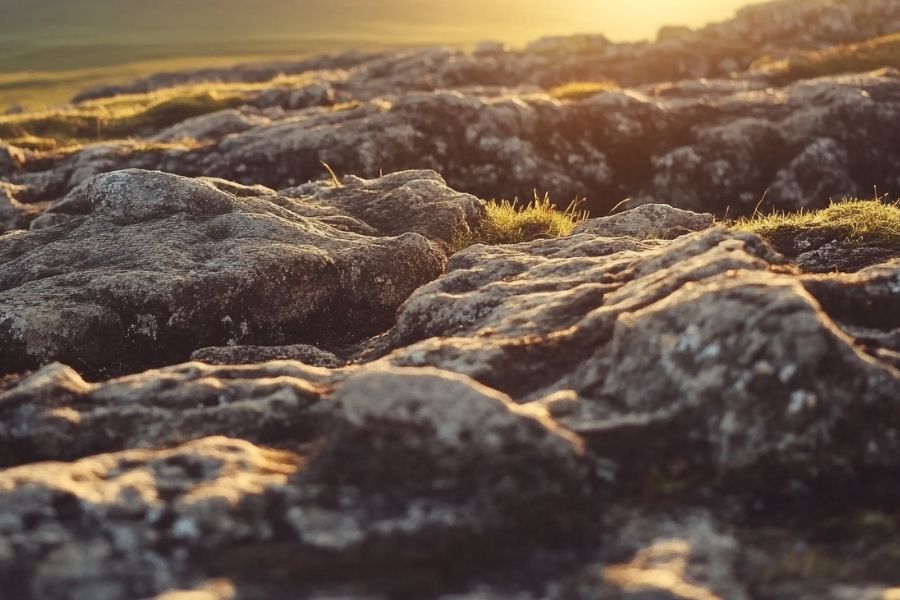
Rocky outcrops
Rocky outcrops are good places to find meteorites because they are areas where erosion has removed softer materials, leaving harder rocks exposed. This natural process can bring meteorites to the surface and make them easier to spot.
Since meteorites are often denser and more durable than many Earth rocks they can survive in these environments for long periods without breaking down completely.
The open, exposed nature of rocky outcrops also minimizes plant cover and soil that might otherwise hide a meteorite.
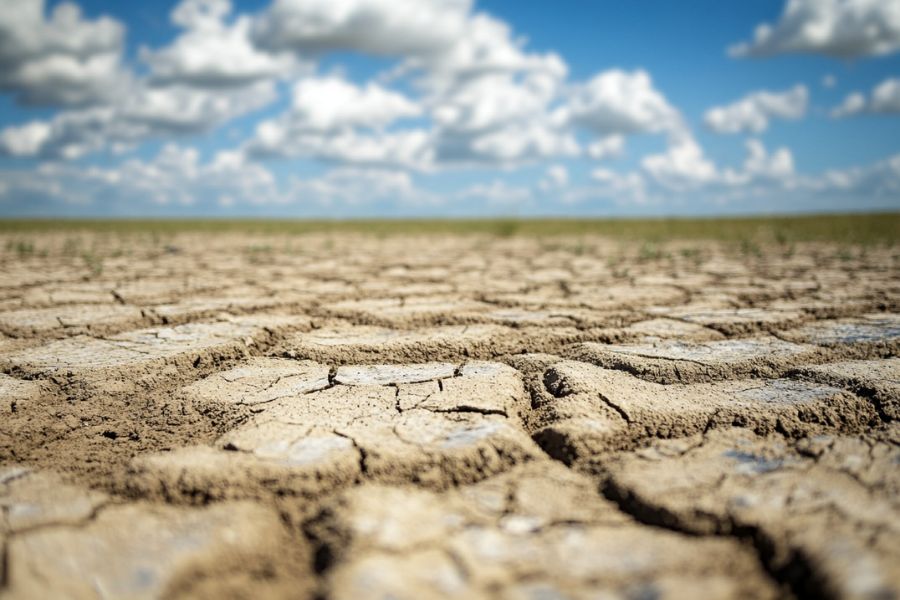
High Plains And Arid Grasslands – ONLY INCLUDE IN STATES WITH THEM
High plains and arid grasslands to be wide, open areas with sparse vegetation and relatively flat terrain. This makes it easier to spot meteorites, which often stand out as dark or unusual rocks compared to the lighter soil and local rocks.
The lack of heavy forest cover or dense plant growth means that meteorites are less likely to be hidden or buried under debris. Additionally, these areas often have minimal erosion and weathering, so meteorites can remain preserved for long periods.
It’s also helpful to look in areas where water or wind might naturally concentrate rocks, like small gullies or depressions. Searching systematically and being patient are key to finding these space treasures on the high plains.
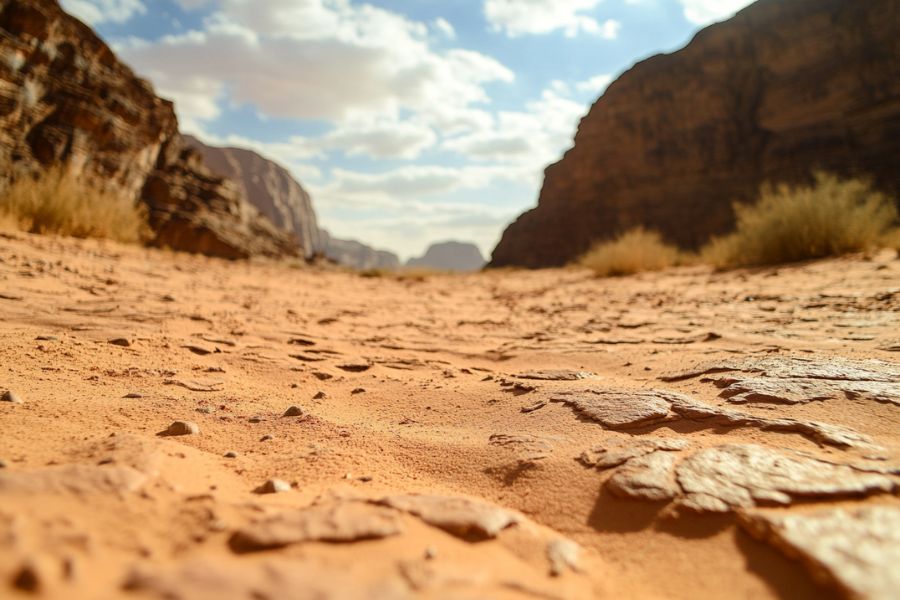
Deserts – ONLY INCLUDE IN STATES WITH DESERTS
The dry climate found in most deserts helps preserve these space rocks for thousands or even millions of years. In wet or humid environments, meteorites can quickly rust or weather away, especially if they contain a lot of metal.
Deserts also have minimal vegetation and open, flat areas, which make it easier to spot unusual rocks on the surface.
The light-colored sand and soil in many deserts provide a stark contrast to the typically dark or metallic appearance of meteorites, making them stand out.
The hard, dry surface of many desert environments will often remain unchanged for years at a time. This makes it possible to spot the small impact craters of recent meteorites.
How To Find Meteorites – Tips & Tricks
Before we get into specific locations I wanted to share a few techniques that will make your search a LOT easier. These are tried and true tips and tricks that have worked for a lot of meteorite hunters over the years.
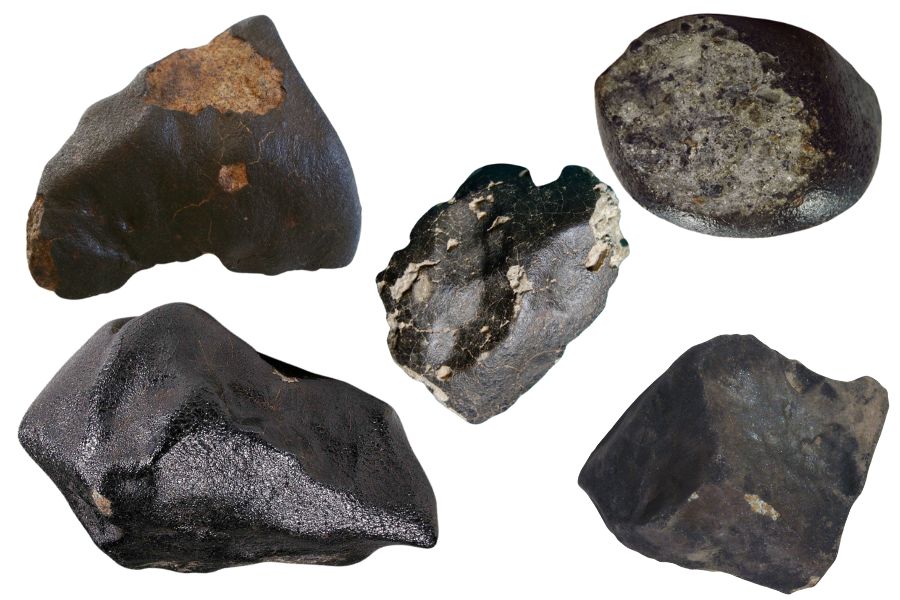
Fusion crusts are a dead giveaway
A fusion crust is a thin, dark outer layer that forms on the surface of a meteorite as it passes through Earth’s atmosphere. During its fiery descent, the intense heat generated by friction melts the outermost layer of the rock, creating this distinctive crust.
The melted material quickly cools and solidifies once the meteorite slows down, leaving behind a smooth or slightly textured coating. This fusion crust is one of the key features that helps identify a meteorite.
To recognize a meteorite by its fusion crust, look for a dark, often black or dark brown layer that appears different from the interior of the rock (as you can see in the image above).
The crust may be shiny or dull, depending on how weathered it is, but it usually contrasts sharply with the meteorite’s inner material.
On some meteorites, the fusion crust can show small cracks or a network of fine lines, caused by shrinking as the crust cooled.
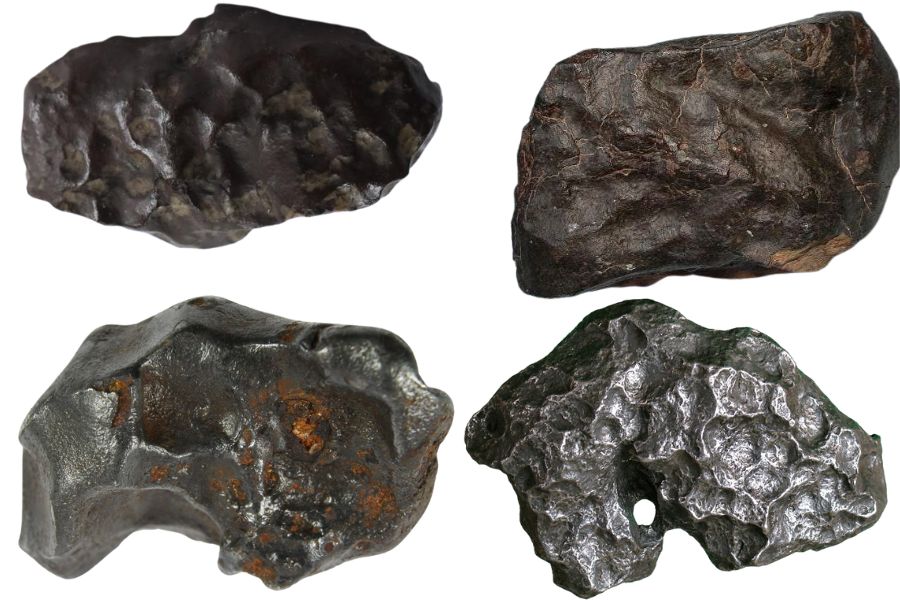
Look for Regmaglypts
Regmaglypts are shallow, thumbprint-like depressions found on the surface of many meteorites. They form as the meteorite travels through Earth’s atmosphere at high speeds, causing its outer layer to melt and flow unevenly due to intense heat and pressure.
The air resistance creates these unique, dimpled patterns as material is ablated, or burned away, during entry. These features are one of the key ways to identify a meteorite because they are rarely seen in Earth rocks.
While regmaglypts can vary in size and shape, they usually look smoother than the jagged, broken surfaces of terrestrial rocks. These patterns are most common on iron meteorites but can also be found on stony or stony-iron meteorites.
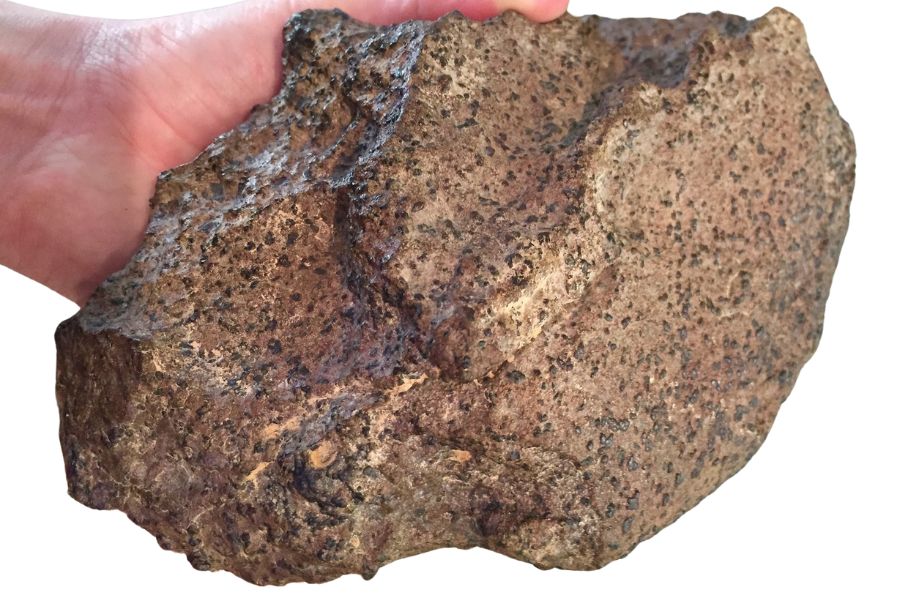
Surprising weight
Meteorites are often much heavier than regular Earth rocks of the same size because they usually contain high amounts of metal, such as iron and nickel.
This density makes weight a key factor in identifying them. When you pick up a meteorite, it will feel unexpectedly heavy for its size compared to typical rocks.
For example, a meteorite the size of a baseball can weigh as much as 2 to 4 times more than an ordinary rock of the same size. This is especially true for iron-rich meteorites, which are nearly entirely made of metal.
Even stony meteorites, which contain more silicate minerals, are denser than most Earth rocks because of their unique composition.

Check for magnetism – You will want a magnetic pickup tool like this
Since most meteorites that survive impacting Earth will have a reasonably high iron content they will typically stick to a decently high-powered magnet. A magnetic pickup tool (basically a stick with a magnet at the end) will make your life a lot easier.
Instead of constantly bending over and looking at rocks you can run your magnet over it. If you don’t feel any resistance you can move on to the next rock.
If you do, or something sticks to the magnet. You’ve found something worth examining further.
You can make this yourself with a magnet, tape and a stick or find one cheaply online like this one.
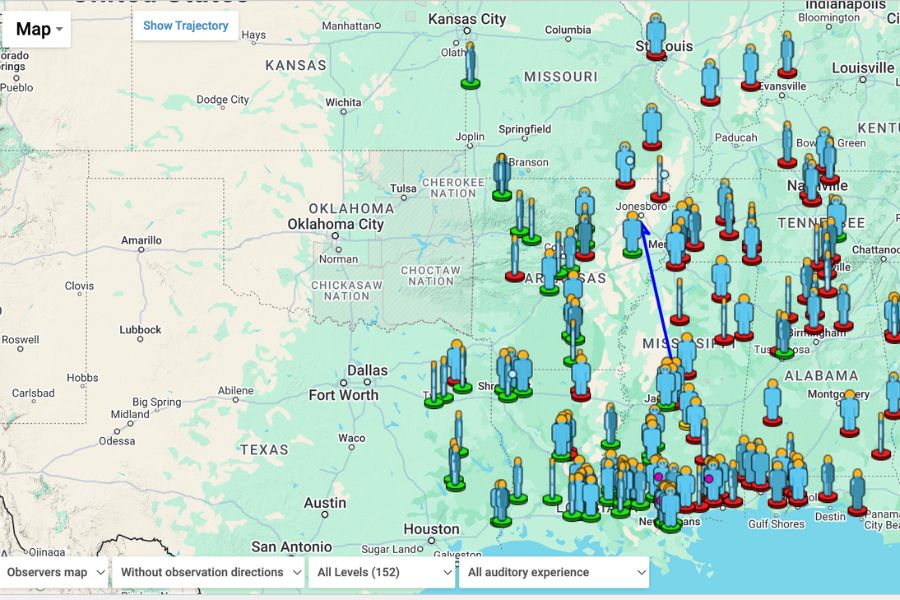
Check out the Fireball report
The Fireball Report is a record of bright meteors, also called fireballs, that enter Earth’s atmosphere and are visible as they burn up. These reports are often compiled by organizations like the American Meteor Society (AMS) or other scientific groups that track meteor activity.
Fireball reports provide important details about the event, such as the time, location, brightness, and trajectory of the fireball. They are based on observations from witnesses and sometimes enhanced by data from specialized cameras, satellites, or radar systems.
Fireball reports can help you find meteorites by identifying areas where meteoroids may have survived their journey through the atmosphere and landed on Earth.
When a fireball is large enough, it may break apart, creating a strewn field—a region where fragments are scattered.
Using the data from the report, such as the estimated impact zone and direction of travel, meteorite hunters can narrow down their search to specific locations.
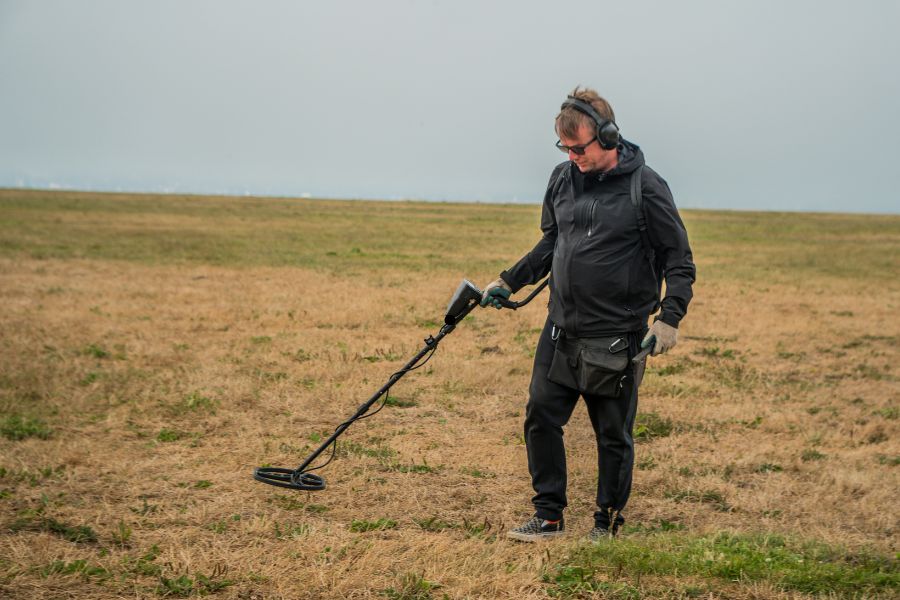
A metal detector can be very handy
Much like a magnetic pickup tool, a metal detector helps you find meteorites by picking up the metal content that is common in many types of these space rocks.
Since most meteorites, especially iron meteorites and some stony meteorites, contain significant amounts of iron and nickel, a metal detector can save you a lot of time searching.
Using a metal detector is especially useful in areas where meteorites might not stand out visually, such as regions with lots of rocks or vegetation.
Some detectors are better than others for this purpose, so choosing a model that can detect a wide range of metal types, including iron, is important. You can adjust the sensitivity to filter out small pieces of junk metal and focus on larger, denser objects.
By methodically scanning an area, a metal detector increases your chances of finding meteorites, even those that are not visible on the surface.
Always Confirm Access and Collection Rules!
Before heading out to any of the locations on our list you need to confirm access requirements and collection rules for both public and private locations directly with the location. We haven’t personally verified every location and the access requirements and collection rules often change without notice.
Many of the locations we mention will not allow collecting but are still great places for those who love to find beautiful rocks and minerals in the wild without keeping them. We also can’t guarantee you will find anything in these locations since they are constantly changing.
Always get updated information directly from the source ahead of time to ensure responsible rockhounding. If you want even more current options it’s always a good idea to contact local rock and mineral clubs and groups
Where To Hunt Meteorites In The State
Here are five great places to start hunting. After we go in-depth with these we’ll provide even more places to search.

Lake City
Lake City is a favorite spot for meteorite hunters, thanks to its exciting history of finds, including pieces from a fireball that lit up the sky in 2016.
Great places to look include farmland and dry creek beds, where the soil is loose, and there’s not much vegetation to hide meteorite fragments. These open areas make it easier to spot unusual rocks that might have fallen from space.
Rain can be your best friend here. After a heavy downpour, water often clears away dirt, making dark, metallic stones stand out on the ground. Searching in the early morning is also a smart move—when the sun is low, its light creates shadows that can help highlight the shapes and textures of meteorites.
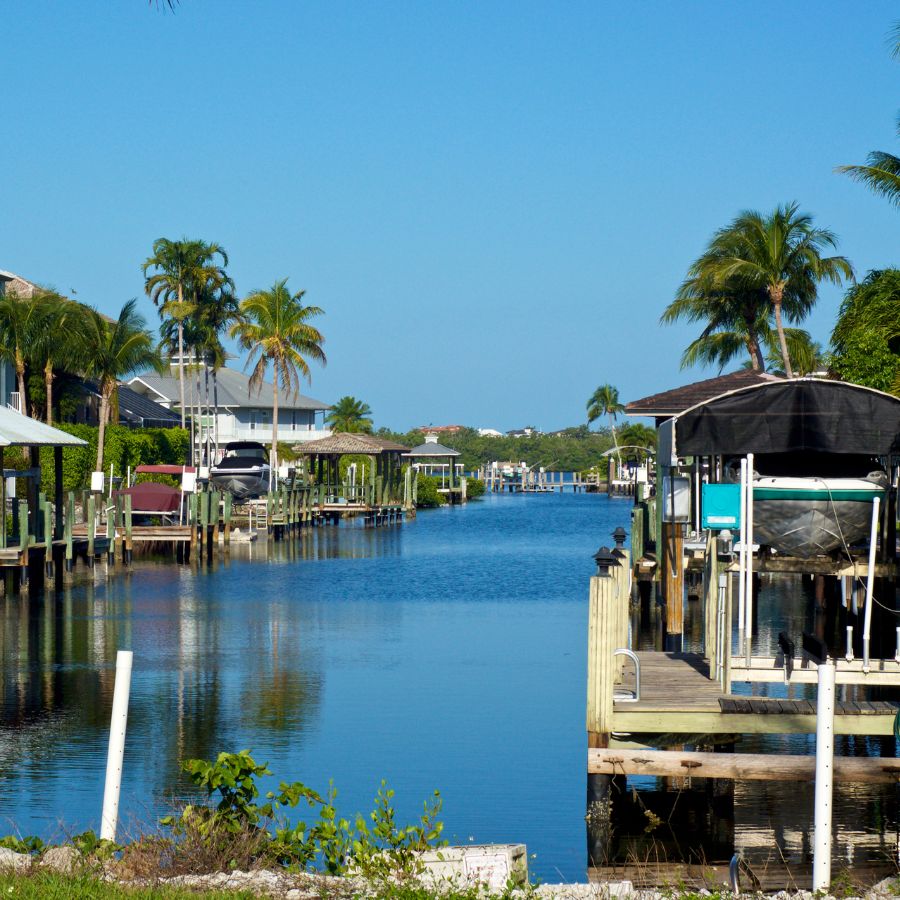
Bonita Springs
Bonita Springs is a famous spot for meteorite hunters because one of the biggest meteorites ever found in the area, weighing over 540 kilograms, was discovered here.
The best spots to look include dry, sandy areas with little vegetation, where dark stones stand out against the lighter ground. Farmland and undeveloped land nearby are also worth exploring since they’re less disturbed and easier to search.
Check places where natural erosion happens, like shallow ravines or sloping ground, as they can reveal buried meteorites over time. Dry weather is perfect for hunting since it keeps dirt from clinging to stones, making it easier to tell meteorites apart from regular rocks.
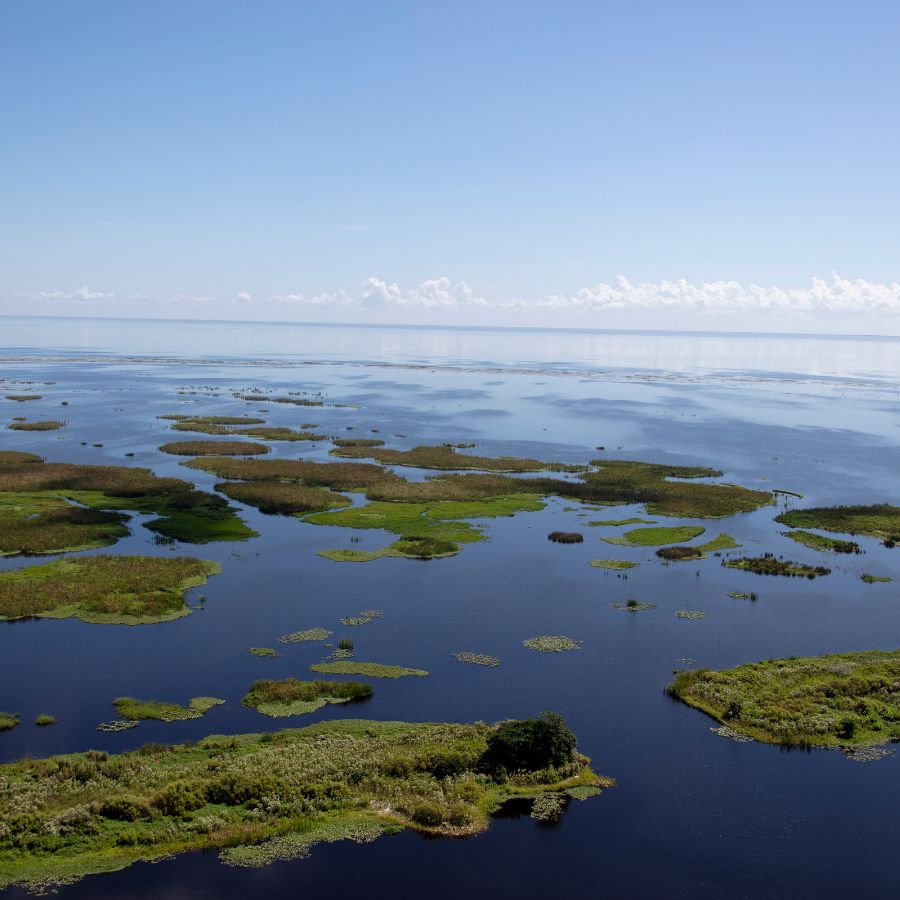
Okeechobee
Okeechobee is an exciting spot for meteorite hunters, with a 41-kilogram space rock discovered there. Its mix of open farmland and flat terrain provides an ideal setting for locating meteorites.
Freshly plowed fields and drainage ditches are top spots to check, as heavier objects like meteorites often settle there. Grasslands with little vegetation are also great since they make it easier to see unusual stones on the ground.
Winter is the best time to hunt, with cool, dry weather that’s perfect for exploring. A pair of polarized sunglasses can help cut down glare, making dark, weathered meteorites stand out even more.
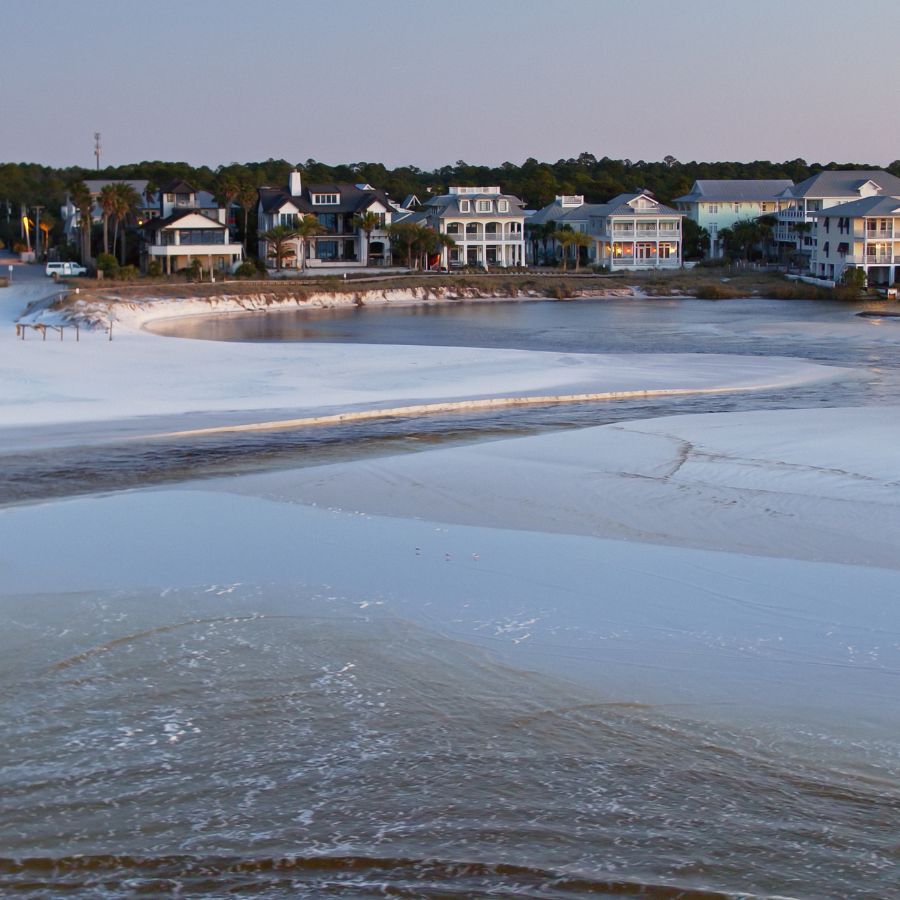
Grayton Beach
Grayton Beach in Walton County is an exciting place to hunt for meteorites, thanks to its wide sandy areas and nearby open land where meteorites are easier to find.
The best spots to search include flat, sandy stretches near the beach and clearings in the nearby forests. Low-lying areas and shallow dips are also worth checking out, as they can trap heavier objects like meteorites over time.
Hunting in the early morning is a smart move because the low sunlight makes it easier to spot unusual shapes and textures on stones.
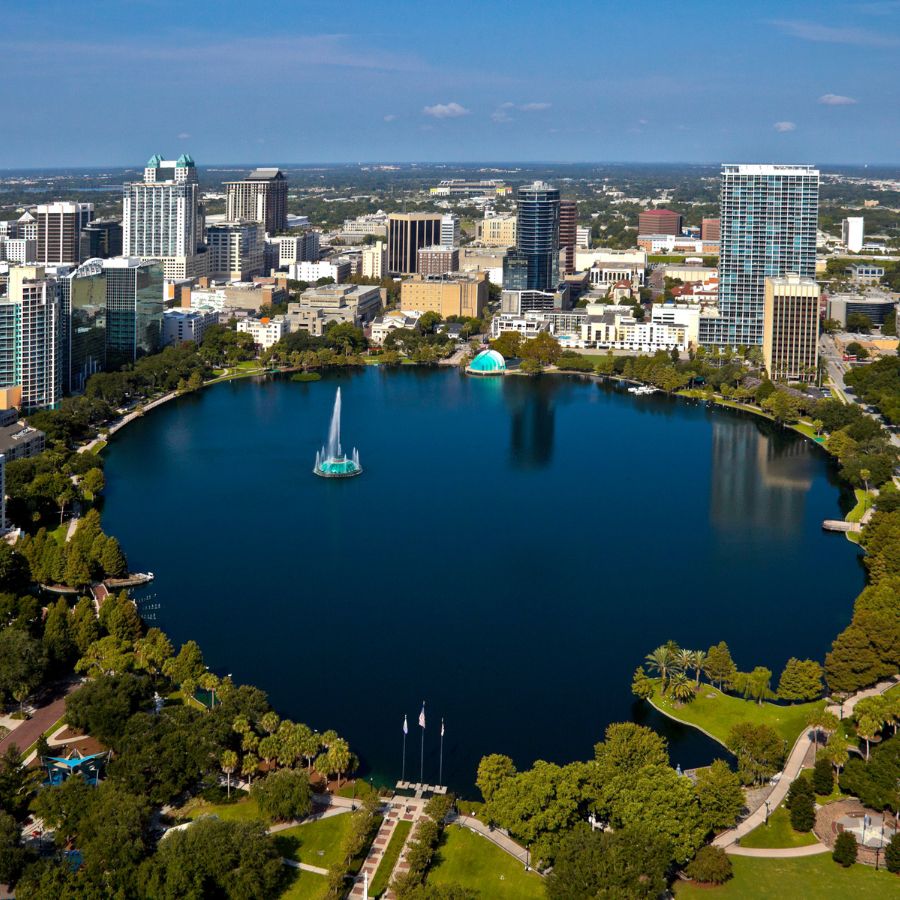
Orlando
Orlando is a fascinating place for meteorite hunters, especially after a eucrite meteorite hit a house there in 2007. The mix of neighborhoods and open land around the city gives plenty of spots to explore for space rocks.
Great places to search include vacant lots, construction sites, and fields where the soil has been disturbed, which can bring hidden meteorites closer to the surface. Retention ponds and stormwater basins are also worth checking since they tend to collect heavier objects like meteorites.
Hunting during dry weather is your best bet, as it keeps mud from covering potential finds. Clear, dry conditions make it easier to spot anything unusual on the ground.
The Full List Of Meteorite Hot Spots
Here is the full list to check out:
| Region | Location Name | Description |
| North Florida | Lake City | In 2016, meteorite fragments were found near Lake City following a daytime fireball event. |
| Osceola National Forest | Fragments from the 2016 fireball were recovered in the Osceola National Forest. | |
Columbia County | Rural areas in Columbia County near Lake City may still hold undiscovered meteorite fragments. | |
| Central Florida | Eustis | A meteorite weighing approximately 4.5 kg was found in Eustis. |
| Mount Dora | Neighboring Mount Dora has rural and undeveloped areas that may hold unrecognized meteorite fragments. | |
| Orlando | In 2007, a eucrite meteorite was recovered in Orlando after it struck a house. | |
| Apopka | Suburban and open areas near Orlando, such as Apopka, offer potential for undiscovered fragments. | |
| Southwest Florida | Bonita Springs | A significant meteorite weighing over 540 kg was found in Bonita Springs. |
| Estero | Estero, close to Bonita Springs, has similar terrain and open spaces worth exploring for meteorites. | |
| Northwest Florida | Grayton Beach | A meteorite weighing over 511 kg was discovered near Grayton Beach. |
| Freeport | Open land in Freeport, near Grayton Beach, may yield smaller meteorite fragments yet to be recovered. | |
| South Florida | Okeechobee | A meteorite weighing approximately 41 kg was found in the Okeechobee area. |
| Clewiston | Nearby Clewiston, with its agricultural fields, may still contain meteorite remnants. | |
| Belle Glade | Belle Glade, close to Okeechobee, offers expansive farmland where meteorite fragments may remain hidden. |
Always Confirm Access and Collection Rules!
Before heading out to any of the locations on our list you need to confirm access requirements and collection rules for both public and private locations directly with the location. We haven’t personally verified every location and the access requirements and collection rules often change without notice.
Many of the locations we mention will not allow collecting but are still great places for those who love to find beautiful rocks and minerals in the wild without keeping them. We also can’t guarantee you will find anything in these locations since they are constantly changing.
Always get updated information directly from the source ahead of time to ensure responsible rockhounding. If you want even more current options it’s always a good idea to contact local rock and mineral clubs and groups

